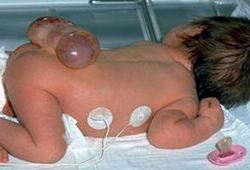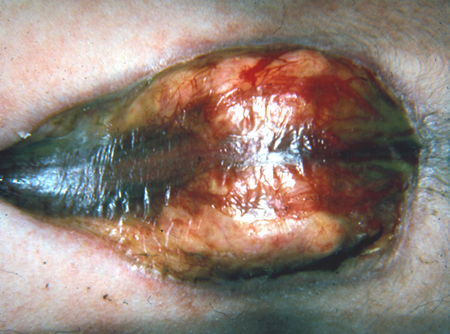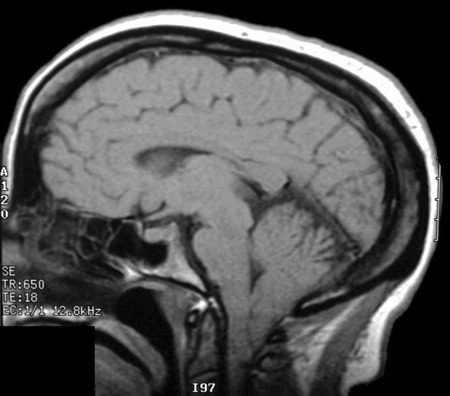Summary
Definition
History and exam
Key diagnostic factors
- maternal risk factors for child with spina bifida
- history of elevated triple or quadruple screening test during antenatal assessment
- history of abnormality on antenatal ultrasound
- open spina bifida lesion: myelomeningocele, myeloschisis, meningocele
- closed spina bifida lesion: asymmetrical gluteal fold or dimple, haemangioma, hairy patch, or other cutaneous markings
- bulging fontanelle
- rapid head growth
- abnormal urinary voiding
- leakage of meconium or stool
- mid-line congenital anomalies: cleft lip or palate, cardiac murmur
- arching of neck
Other diagnostic factors
- absence of anal wink/rectal tone
- downward deviation of the eyes (sundowning)
- upward and lateral deviation of eyes
- abnormal cry
- breathing abnormalities: apnoea, inspiratory stridor, snoring
- facial asymmetry
- asymmetry of spontaneous arm and leg movement
- difficulty with changing nappies or dressing
- abnormal muscle tone and bulk in arms and legs
- decreased sensation
- hip subluxation or dislocation
- club foot (equinovarus deformity)
- vertical talus deformity
- hip and knee flexion contractures
- feeding difficulties
- congenital scoliosis
- congenital kyphosis
Risk factors
- inadequate maternal folate intake
- previous pregnancy affected by spina bifida or other neural tube defect
- maternal history of spina bifida or other neural tube defect
- Hispanic ancestry or ethnicity
- trisomy 18 or trisomy 13
- antenatal exposure to valproic acid, carbamazepine, isotretinoin, or methotrexate
- inadequate maternal vitamin B12 intake
- maternal obesity
- maternal diabetes
- female sex of infant
- 22q deletion syndrome
- low socioeconomic status
- elevated maternal core body temperature during first trimester
Diagnostic investigations
1st investigations to order
- antenatal triple/quadruple test
- antenatal ultrasound
- fetal MRI
- cranial ultrasound
- spinal ultrasound
- CT head
- urine culture
- serum urea and creatinine
- renal ultrasound
- urodynamic study
- voiding cystourethrogram (VCUG)
Investigations to consider
- antenatal amniocentesis or postnatal chromosomal analysis
- fluorescence in situ hybridisation (FISH) testing
- MRI brain and spine
- hip ultrasound
- hip x-ray
- fetal echocardiography
- polysomnography
Treatment algorithm
Contributors
Authors
Nienke P. Dosa, MD, MPH
Professional Advisory Council, Spina Bifida Association of America
Upstate Foundation Professor of Child Health Policy
Medical Director, Spina Bifida Center of Central New York
SUNY Upstate Medical University
Syracuse
NY
Disclosures
NPD is a member of the Professional Advisory Board of the Spina Bifida Association of America; a member of the Planning Committee for the Spina Bifida World Congress, March 2023; and a panelist for the Global Health Symposium at the Spina Bifida World Congress, March 2023. NPD is an author of several references cited in this topic.
Zulma Tovar-Spinoza, MD
Assistant Professor of Neurosurgery
Director of Pediatric Neurosurgery
Department of Neurosurgery
Golisano Children's Hospital
SUNY Upstate Medical University
Syracuse
NY
Disclosures
ZTS is a consultant for Monteris Medical.
Matthew D. Mason, MD
Assistant Professor of Pediatric Urology
Department of Urology
Assistant Dean for Clinical Sciences
SUNY Upstate Medical University
Syracuse
NY
Disclosures
MDM declares that he has no competing interests.
Acknowledgements
Dr Nienke P. Dosa, Dr Zulma Tovar-Spinoza, and Dr Matthew D. Mason would like to gratefully acknowledge Dr Jonathan V. Riddell and Dr Danielle A. Katz, previous contributors to this topic.
Disclosures
JVR and DAK declare that they have no competing interests.
Peer reviewers
Leslie N. Sutton, MD
Chief of Division of Neurosurgery
Director of Neurosurgery Fellowship Program
The Children's Hospital of Philadelphia
Philadelphia
PA
Disclosures
LNS is an author of several references cited in this topic.
Dominic Thompson, MBBS, BSc, FRCS(SN)
Consultant Pediatric Neurosurgeon
Great Ormond Street Hospital for Children
London
UK
Disclosures
DT declares that he has no competing interests.
Use of this content is subject to our disclaimer


